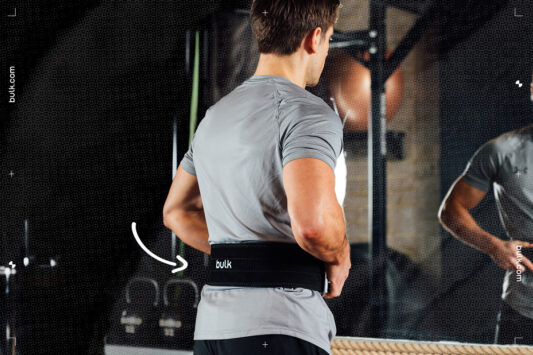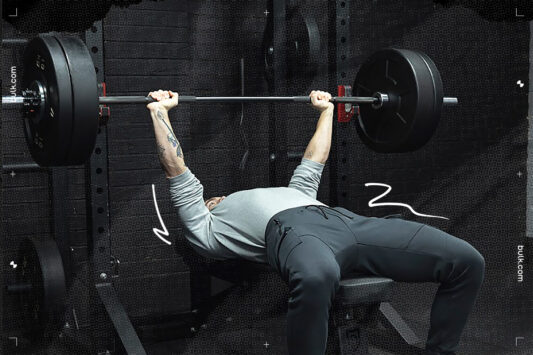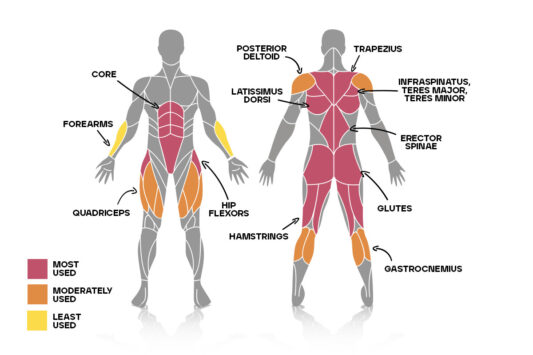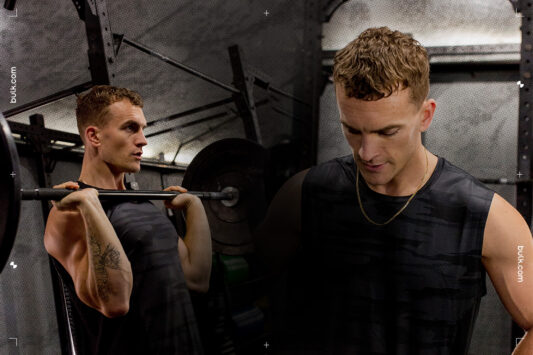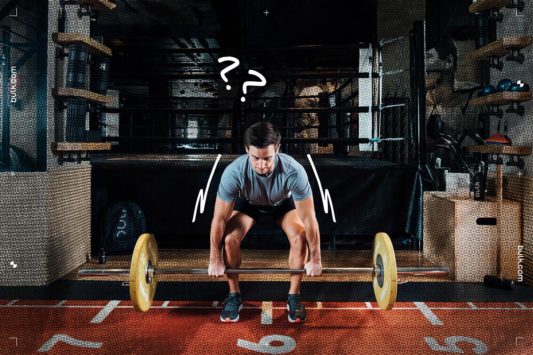Harnessing the power of your entire body, the deadlift is the ultimate test of raw physical strength. From our ancestors moving big rocks across expansive plains, to the modern lifter pulling barbells in commercial gyms, it’s all just picking up something heavy and putting it down. Primal, instinctive and the pinnacle of functionality. No wonder it feels so good to train. You’re here to learn how to increase your deadlift, so here we provide six steps on how to do just that.
1. Use physical cues to get into the correct position
Leg, shin and knee position
For a conventional deadlift, there are some minor debates around foot position. Generally, shoulder-width apart with your feet facing forward is a good indicator. A narrow foot position means that there is as little range of motion as possible, meaning the bar has less distance to cover to be lifted.
How to get your legs in the correct position for a deadlift:
- Stand a touch narrower than shoulder-width apart, with the bar going straight through your midfoot.
- Without bending your knees (yet), drop your arms vertically until they touch the bar. You want your arms to be straight (imagine they are long hooks from a crane).
- Next, sink your hips and bend your legs so that your shin is touching the bar. While doing this, do not move the barbell.
- This hip movement should mean your knees are tucked into the insides of your elbows. If they are not touching, it’s likely your initial width was too far apart. Adjust until you are in the correct position, with your knees tucked inside your elbows.
Back position
If your physical cues are correct, your back should get into a proper position naturally. With your shins, legs and arms in the correct position, pump your chest out. This should see your shoulder move backwards, and naturally generate the correct position in your back.
When you’re in this position, it’s time to brace and tighten up. Take a big deep breath in, sucking up your core as if you’re about to receive a body shot from Anthony Joshua, then tighten up your lats. At this point, your body should be desperate to explode upwards.
How to get your back in the correct position:
- With your feet, knees and hands in the correct position, visualise lifting your chest up and pushing it out. This should get your hips and back in a position where it feels tight and solid.
- As you do this, you should naturally feel ‘heavy in your hands’, meaning you can feel the weight of the bar, but aren’t generating enough force yet to lift it from the ground. It’s like a little tease. As soon as you engage your legs with purpose and power, that bar should rip off the floor.
2. Use mental cues to increase power
We’ve talked about the importance of physical cues when it comes to deadlifting, but mental cues are equally important. These are what you are thinking to prepare and complete your rep as best as possible.
Here’s one for you to try: when exploding off the floor is think of ‘push the floor away’. This vision helps activate the legs and explode off the ground and ensures you use the muscles in your quads, which are often under-utilised.
Once you’re past the knees, another cue is to ‘push your hips through’. This allows you to rapidly bring your hips to the barbell after the bar travels above the knee.
What mental cues to use during the deadlift
- When you rip the bar off the floor, imagine you’re doing a leg press, pushing the entire Earth against you below.
- Lift the bar past the knees and ‘push your hips through’ until your legs are straight and locked out. That’s a rep.
Advanced mental cues
When Eddie Hall lifted his famous world record 500kg Deadlift in 2017, he took mental cues to the extreme. Hall said that when he lifted that 500kg bar, he wasn’t in Leeds at the World Deadlift Championships, he was protecting his family from a threat. He believed engaging with these deep, dark thoughts allowed him to activate primal instinct. This helped him squeeze an extra few percentages required to lift the momentous amount.
This is an extreme case and probably is not recommended for your standard lifter on platforms. It does, however, demonstrate the incredible power our mindset has on lifts. There’s a great quote from Henry Ford that says, “Whether you believe you can do a thing or not, you are right”. This applies directly to ambitious exercises, whether it’s a lung-busting marathon or monster deadlift.
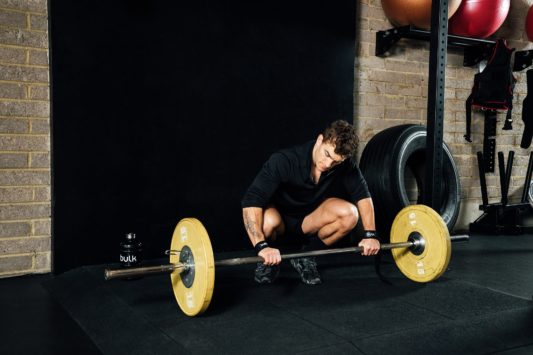
3. Have a familiar warm-up routine
Warm-ups are boring, right? Not necessarily. If you have your routine in place, a warm-up can be a great way to build anticipation and longing to slap more weight on the bar. Not to mention it decreases the likelihood you’ll get injured.
There are myths about deadlifts that it’s some sort of dangerous deathtrap of a movement. This just isn’t true. Saying that, warming up is important to ensure you don’t get any nasty surprises. Make sure to use dynamic stretches like lunges, squats and light stretches to prepare your body for the lift. Pick up the bar and load up, adding a little more each time. (‘A little more’ is very subjective, and could be 10kg if you’re a novice, or 40kg if you’re more experienced).
But warming isn’t just about avoiding injury, it’s about optimising performances. It’s about getting your muscles fired up and ready to lift. You want your body in explosive mode come that first working set.
4. Do accessory movements to support relevant muscles
Accessory movements are other exercises that help facilitate a better lift in your key compound movements. Although the deadlift uses almost every muscle in the body, there are some used more than others. These are the lats, hamstrings, quads and core.
The best accessory movements are variations on the deadlift itself. These include stiff-leg deadlifts, Romanian deadlifts and even paused deadlifts. If you want lesser know (but super effective) movement, there’s also Woolam Rows.
For a guide on Romanian deadlifts vs deadlifts, check out our blog which explains the difference between these movements.
5. Train for a peak, not for ego
A common mistake is training to RPE 10 (maximum effort) every session. When it comes to testing yourself, your body is already burnt to a crisp. Your visceral system is screaming for a holiday. The importance of being patient is paramount, and following a programme that slowly builds up to your goal weight.
Work to heavier weights with small, incremental improvements. Don’t jump around to heavier weights and lighter ones because you’re getting restless, trust the process and keep your eye on the date where you are going for the PB. In the time it takes to lift a big hunk of metal off the floor, it all becomes worth it.
Impatient lifters get injured, meaning they end up further away from their goals, or never hit them at all.
6. Use equipment
How to use straps for deadlift
Lifting Straps allow you to lift heavier weights. In deadlifts, your hands function merely as hooks. Grip strength is often a limiting factor when it comes to lifting heavy, but straps sort out your grip for you. This means you can see your true strength potential. That said, natural grip strength is still important, so it’s recommended that you only use straps in your heaviest sets.
If you want a definitive guide on how to use lifting straps, check out our blog. While we’re on the subject, lifting straps are not to be confused with Wrist Wraps, which are used for push exercises like bench press and shoulder press. It happens all the time, so it’s worth reiterating that.
How to use a lifting belt for deadlift
A Lifting Belt relieves stress on the lower spine when picking up free weights from the ground. The International Powerlifting Federation has made it compulsory for all professional athletes, which tells you the importance of a belt.
By squeezing your abdominal cavity, a lifting belt helps support your lower back. The belt creates intra-abdominal tension, which provides good support to the lumbar discs, reduces spinal stress and helps prevent injury.
The belt is not only helpful for deadlifts, but it also helps you maintain your stability and core pressure during any kind of rowing movement.
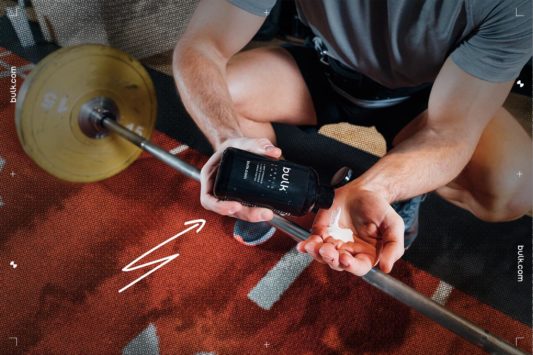
How to improve grip strength for deadlift
Two ways to do this with equipment is via is to use Lifting Straps and Liquid Chalk. However, it’s also good practice to improve your natural grip strength, and there are many effective ways to do this.
‘Dead hangs’ use your body weight to strengthen your natural grip. All you need is a straight pull-up bar, or just any elevated straight bar. Grip it, ensuring your whole body is elevated, and stay there as long as possible. The heavier you are, the harder this is of course, but aim to get up to a minute.
Another simple way to improve grip strength is to perform a deadlift, and rather than putting it down, hold it at the lockout for as long as you can. After a few seconds, your grip will be screaming. Hold on until it drops.
How much should you deadlift?
This varies a lot depending on various factors, the main one being body weight. As a beginner, the load on the bar should not be too much of a concern, as it’s all about nailing technique. You just need the bar to counteract your own body weight (so it would need to be heavier than your body weight).
As you get stronger and more comfortable with the technique, your aim should be to attain a maximum deadlift of 2.5 x your body weight for men, and 2 x your body weight for women. To be clear, this is a maximum one-rep deadlift to work up to, not something you should be attempting every deadlift session.
In the sessions preceding, working sets of 5×5 at around 85% of your 1RM is a decent starting point to build a solid foundation. As you get closer to testing your maximum, drop the volume (reps and sets) and increase the intensity (weight).
We believe in sharing, and we’d love to know what you think, so don’t forget to tag us in your workouts, especially if you’re using Bulk™ equipment like our Lifting Straps. Check out @bulk for more recipes, ambassador workouts and tips. Join our community of fitness lovers and foodies by tagging #TeamBulk.
Related articles
Looking to learn more? We believe that every person, with support, has the right to transform their lives through fitness. That’s why we’ve put together hundreds of articles with expert advice, all to help you on your fitness journey. Here’s some more articles around deadlifts and other leg-related movements.
Romanian deadlift vs deadlift Deadlifting for beginners
Bench press variations How to improve pulling power
Deadlifting with expert powerlifter How to train hamstrings
Hip warm-up for squats How to build big quads
Gym exercises for footballers How to train your posterior chain
Deadlift muscles worked











